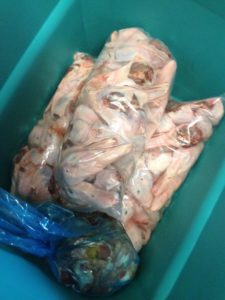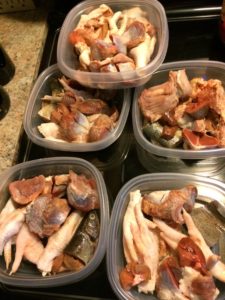Before going into practical tips for preparing and portioning raw meals for your dog, I would like to say that the seasoned raw feeders I trust and was lucky enough to learn from recommend following these simple guidelines when feeding your dogs raw:
- Feed a minimum of 3-4 proteins for balance
- Introduce new proteins slowly, one protein at a time and least 2 weeks apart from each other
- A balanced meal should contain 10% bone, 80% muscle meat, 10% organ (from which, half should be liver)
- Unless you feed all wild meats, supplement with natural fish oil to supply Omega 3
- Do not feed plant matter or dairy
- Each meal does not need to be precisely balanced, but over the course of a week, pay attention to the ratio above
I have had the pleasure to meet quite a few raw-feeders on this journey and learned about different styles. There are two extremes when it comes to portioning the meals:
1. Meticulous calculation and menu planning. For this a scale is a must.
2. Eyeballing rather than weighing, pulling out a few bags out of the freezer, often balancing too much of muscle meat or organ with bone in the next meal and vice versa.
Each of these approaches has merit. The first style is definitely more time-consuming and the second one is probably something that a new raw feeder should not practice until they get comfortable with a raw feeding routine and after the dog adjusts to raw.
Another alternative is to feed pre-made raw grinds. It is a convenient choice but more often than not it is a more expensive option. There are some good brands that you could find which source meats from organic or local farms and follow the feeding guidelines I mentioned in the beginning of this article. One challenge with feeding pre-made food exclusively is that even your manufacturer is precise and consistent about the ratio, you could still experience issues, because your dog might have a reason to need more/less bone or organ than the classic 10-80-10(5) ratio mentioned above. You can usually tell by the dog’s stool if more bone or more organ should be fed.
Putting the meals together myself provides me more flexibility, I believe, because my dogs can more quickly adjust to variations in the diet. Sometimes I am on the go, or have relied on a grocery store for meat to feed; while other times I am able to pickup from a local farmer or score some cheap (or better free) meat during the hunting or fishing season. If I were exclusively feeding grinds, my dogs would have more difficulty adjusting to irregularities in the meals.
My dogs love their bones and mixed whole meat bowls, and I can see it pays off to learn how to put meals together yourself, while also using pre-made grinds occasionally for convenience or incorporating them into the meals to provide protein variety. When I travel, or someone watches my dogs, for any reason, I portion meals into individual containers (truly one container per day, but you could do one per meal.) If you’d like to make meal boxes for your dogs, here are some tips:
1. You can re-freeze meat as many times as you need. Re-freezing meat for human consumption is normally not recommended, because it loses taste as it loses the moisture. But believe me, your dog will still eagerly enjoy the raw meal you are offering. Freezing doesn’t ruin the meat.
2. Thawing is an essential part of portioning, I use a plastic tote with a lid: there is no mess and dogs won’t get into it. I get big totes, so they can fit a 30-60lb case, if needed. A tote catches blood too and you can add it back into the meals, if you’d like. 
3. When buying large quantities (a whole animal or a case), it is helpful to break it down into 2-6lb portions depending on the size of your dog, because it is easier to manage and easier to fit into the freezer. That way, when you have to prepare meals, you would only need to pull out one bag instead of a whole case.
4. While some people prepare meals for 1 week at a time, some might do it for a whole month. It depends on your schedule and is your choice. Preparing meals in advance is a good idea when you are traveling or working late and someone else has to feed your dog.
5. You can use re-usable plastic containers or plastic bags for packaging meals. Using “free” plastic shopping bags can be a good option, but I recommend doubling them. I use reusable plastic containers, they take up a little more space in the freezer, but are so convenient. My containers are clear with a blue lid that snaps in place. I wash them and reuse them. If you choose to go this route, try not to drop one on the floor while frozen, as it will shatter! I wash them by hand, and then wash them again in the dishwasher to make sure they are sanitized before the next use.
6. Prepare/package your dogs meal boxes (meal bags, if you’re using bags)! Variety is the key for my dogs: I typically use 3-4 proteins when portioning for 1-2 weeks. A meal box may include a bone source: chicken or duck head, feet, chicken back, chicken, drumstick or rabbit leg, plus muscle meat: heart, gizzards, pork or beef, plus organ meat: liver and any other organ meat I have on hand. I also throw in some seasonal goodies like venison or trout. 
The fun part of portioning is that your dog will supervise you. She probably thinks you are a great hunter!


I am currently feeding my newly rescued 3 yr old female boxer pre made turkey and rabbit patties. It is expensive and I want to add bone muscle and organ meats. I am new to raw feeding but feel it is the heaviest way to feed my dog. I am looking for a local co op in my area. Dallas ga. Thank you.
Hi Dolores,
We have a monthly pickup in Cumming GA, if this is too far for you, you can also use our co-op https://www.facebook.com/groups/557096614446876/, we do MyPetCarnovore order every other month that you can pick up in Canton.